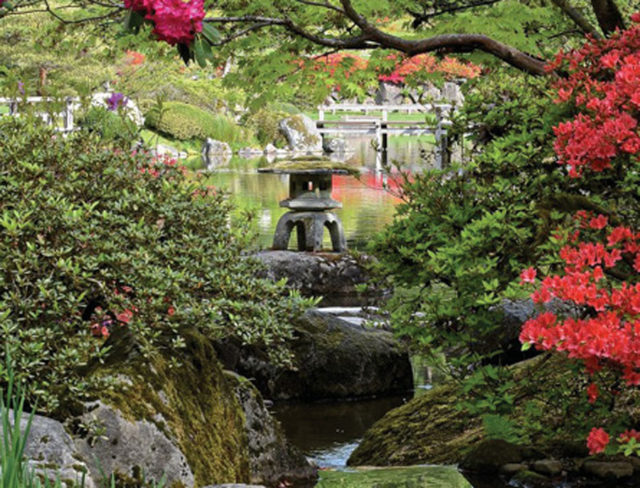by David Yamaguchi, The North American Post
June 5, 2020 marks the 60th anniversary of the opening of the Seattle Japanese Garden at Washington Park Arboretum. Accordingly, special programming is underway across summer and autumn to celebrate the occasion. The garden has adopted the theme of “kanreki” for the events, which means one’s 60th birthday. It is a time of rebirth and renewal.

As the garden remains temporarily closed to the public, early kanreki content is being shared on the garden’s website (seattlejapanesegarden.org), with onsite continuation planned for later in the year. An exceptional example is Michelle Kumata’s “Northwest Nikkei” art installation, which is online through June 30.
Managed in partnership by Seattle Parks and Recreation and the Arboretum Foundation, the 3.5-acre public garden is a cultural treasure for our region. Its design was inspired by the “stroll gardens” of early 17th-century Japan. These invite visitors to journey along winding paths through Japan’s varied landscapes: mountains, forests, waterfalls, rivers, lakes, islands, and the sea. About 800 tons of local Bandera Mountain (Snoqualmie Pass) boulders were used to create the Seattle garden’s dramatic waterfall and other landscape features.
New at the garden this year is a special partnership with Green Legacy Hiroshima (GLH; glh.unitar.org). GLH is a Hiroshima non-profit organization that distributes seeds from trees that survived the atomic bombing. In January, the Seattle Japanese Garden became the first partner in the Pacific Northwest to receive GLH seeds. The partnership furthers the long and meaningful relationship between Seattle and Japan, acknowledging the past while shaping a greener and more beautiful future. The garden staff advises keeping an eye on their website for developing details of the kanreki anniversary events.
Seattle Garden in Perspective
To place Seattle’s Japanese garden in context with its peers, There are over 100 such gardens in the U.S. Several of these are listed in the table below. Of these, Seattle’s makes the “best ten” or “best 15” lists consistently. Three such polls posted online since 2010 are those of Sukiya Living Magazine (rothteien.com, 2013), USCityTraveler.com (2014), and JapanObjects.com (2018). In these, the Seattle Japanese Garden’s average rank is 5. Here, it tracks closely behind that of Portland, Oregon, which holds the lead at 1. Notably, the Japanese Garden in Bloedel Reserve, Bainbridge Island, also makes two of the below lists.
In time, the Seattle Japanese Garden places toward the early end of such gardens in North America (table). The listed gardens show that US-Japan relations changed in the 1950s. Most gardens follow the signing ot the Treaty of San Francisco (1951, effective April 1952), which reestablished peaceful relationships between the Japan, the U.S. and other countries. After this agreement, Japanese garden specialists resumed travel overseas to work with North Americans to develop Japanese gardens.
Selected North American Japanese Gardens
By Date of Origin and Size
1894 Japanese Tea Garden, San Francisco (the oldest in the US), 5 acres
1915 Japanese Hill-and-Pond Garden in Brooklyn Botanical Garden, NY, 3
1958 Shofuso, Philadelphia, PA, 1.2
1960 Seattle Japanese Garden, 3.5
1960 Nitobe Memorial Garden, Vancouver, B.C., 2.5
1963 Portland, OR, 12
1974 Nishinomiya Tsutakawa Garden, Spokane
1977 Morikami Park, FL, 189
1977 Seiwa-en Japanese garden at Missouri Botanical Garden, St. Louis, 14
1978 Anderson Gardens, IL, 12
1982 Elizabeth Malott Japanese garden at Chicago Botanic Gardens, 17
HISTORY
| Year | Events |
|---|---|
| 1909 | Japanese pavilion and garden are built for the Alaska-Yukon Exhibition, a world’s fair held at the UW. These ignite local interest in Japanese gardens. |
| 1934 | Olmsted Brothers build UW Arboretum. |
| 1937 | Local officials decide the Arboretum needs a Japanese garden. |
| 1957 | Arboretum Foundation begins raising funds for making the garden. |
| 1958 | Foundation representatives meet with Tatsuo Moriwaki, head of Tokyo Metropolitan Parks, who inspects the proposed garden site and generously offers to provide landscape plans and a teahouse. A team of Japanese landscape architects begins work on the design, including Juki Iida. |
| 1959 | Mr. Iida comes to Seattle to supervise garden construction. He hires local Japanese-American gardeners and artisans to shape the landscape, install rockwork and plants, and build wooden structures. |
| June 5, 1960 | The garden opens to the public. |
| Oct 5, 1960 | Crown Prince Akihito and Princess Michiko visit the garden and donate a Japanese cherry and a white birch (native to North America) tree. Their Seattle visit commemorates the 100th anniversary of the Treaty of Amity and Commerce between the US and Japan. |
| 1973 | The original teahouse, donated to Seattle by the people of Tokyo, burns down. The current teahouse, an identical reconstruction, reopens in 1981. |
| 2007-2009 | A new gatehouse building complex gives the Garden a world-class entrance. Designed by Hoshide Williams, Architects, and Nakano Associates, Landscape Architects, the complex features an elegant courtyard, a meeting room, new restrooms and maintenance facilities, and bronze gates by sculptor Gerard Tsutakawa. |
Garden in 1960



The Present



Photo credits:
Garden construction, Seattle Times.
Imperial visit, Ikebana International.
Present, David Rosen.
Content sources: Press release by Arboretum Foundation staffers Jessa Gardner and Niall
Dunne. Imperial visit: North American Post, Oct.6, 1960. Ito Kazuo, 1969, “Hyakunen sakura.”
Seattle Japanese Garden is one of the most highly regarded Japanese-style gardens in North America. Tucked within a vast arboretum in a fast-growing city, the garden attracts over 100,000 visitors annually.
1075 Lake Washington Blvd E, Seattle, WA 98112
Tel: (206) 684-4725
Japanese Imperial Visit in 1960

Jeanne Peterson,
the Seattle Japanese Garden Steering Committee Chair








